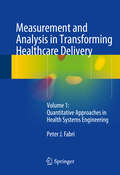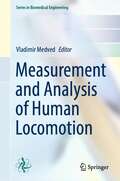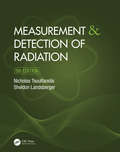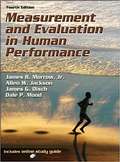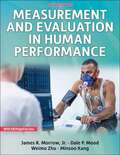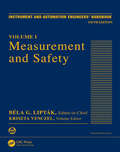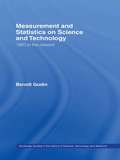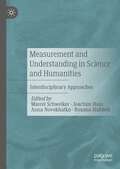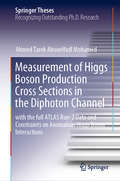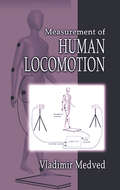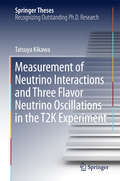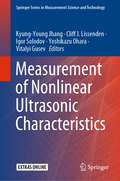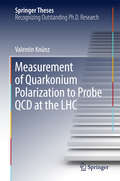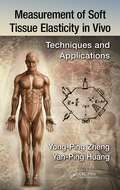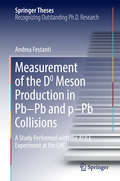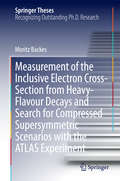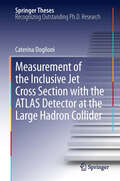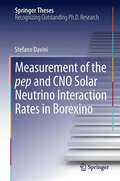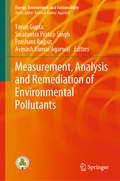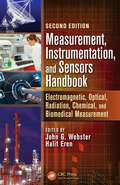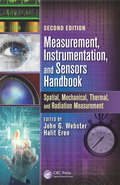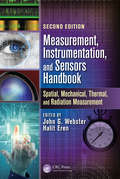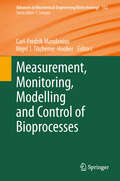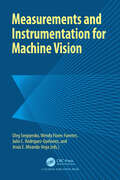- Table View
- List View
Measurement and Analysis in Transforming Healthcare Delivery
by Peter J. FabriThis volume provides the important concepts necessary for a physician to participate in a reengineering process, develop decision-making skills based on probability and logic rather than "rules," and to measure and analyze meaningful outcomes of care delivery. This approach has been developed over ten years in a medical student-based program and has been enthusiastically embraced by medical students without backgrounds in engineering or statistics. More specifically, this text will introduce physicians to relevant and available computer software, combined with an in depth knowledge of measurement, variation, and uncertainty. It provides a basis for the transformation of data into information, information into knowledge, and knowledge into wisdom. The first quarter of the book will address understanding and visualizing data, using statistical and graphic analysis. The next quarter addresses the fundamentals of applied statistics, and the application of conditional probability to clinical decision making. The next quarter addresses the four "cornerstones" of modern analytics: regression, classification, association analysis, and clustering. The final section addresses the identification of outliers and their importance in understanding, the assessment of cause and effect and the limitations associated with retrospective data analysis. This toolbox will prepare the interested physician to actively engage in the identification of problem areas, the design of process-based solutions, and the continuous assessment of outcomes of clinical practice. Armed with this toolbox, the reader will be "prepared to make a difference" in the rapidly changing world of healthcare delivery. Measurement and Analysis in Transforming Healthcare Delivery is an excellent resource for general practitioners, health administrators, and all medical professionals interacting with healthcare delivery.
Measurement and Analysis of Human Locomotion (Series in Biomedical Engineering)
by Vladimir MedvedThis book addresses instruments, methodologies and diagnostic methods used to evaluate and diagnose human movement, locomotion and physical status in general. Starting from historical perspective, the idea of understanding human locomotion by applying technical measurement devices and incorporating measurement data into physical representation of gross body movement is presented and explained, an approach known as inverse dynamics. With this approach as a kind of umbrella concept, components of measurement systems including relevant signal and data processing methods are described. Modern instruments to capture body movement by measuring its kinematics, kinetics and surface electromyography (sEMG) are thus described; all systems being used dominantly—if not exclusively—in a movement analysis laboratory setting. Focusing mainly on human posture and gait, but including also examples of movement patterns from selected kinesiological and sports activities, the book attempts to present essentials of biomechanics and biomedical engineering approach to this subject matter. It illustrates how data collected and elaborated by modern engineering technology can complement traditional expert knowledge of a kinesiologist or a medical doctor. The book is applicable in the fields of sports, physical activities, as well as in medical diagnostics and rehabilitation. The examples of this book’s practical application might be in evaluation of efficiency of human gait, in evaluation of skeletal muscle fatigue in physical exercise, in biomechanical diagnostics of traumatological conditions requiring orthopaedic treatment and the like. This book can also be used in planning and executing research endeavours, particularly in a clinical context as a reference for various diagnostics procedures. It presents the lecture notes of a course carrying the same name within Medical Studies in English at the University of Zagreb for more than a decade.
Measurement and Detection of Radiation
by Nicholas Tsoulfanidis Sheldon LandsbergerAs useful to students and nuclear professionals as its popular predecessors, this fifth edition provides the most up-to-date and accessible introduction to radiation detector materials, systems, and applications. There have been many advances in the field of radiation detection, most notably in practical applications. Incorporating these important developments, Measurement and Detection of Radiation, Fifth Edition provides the most up-to-date and accessible introduction to radiation detector materials, systems, and applications. It also includes more problems and updated references and bibliographies, and step-by-step derivations and numerous examples illustrate key concepts. New to the Fifth Edition:• Expanded chapters on semiconductor detectors, data analysis methods, health physics fundamentals, and nuclear forensics.• Updated references and bibliographies.• New and expanded problems.
Measurement and Evaluation in Human Performance
by Jr. Dale P. Mood James R. Morrow Allen W. Jackson James G. DischMeasurement and Evaluation in Human Performance, Fourth Edition, paves the way for students and professionals to identify and solve human performance problems in the areas of kinesiology, physical education, health, and fitness. Focusing on the concepts of reliability, objectivity, and validity, the text introduces students to tests and measurements and guides them through statistical decision making and accurate interpretation of data. Measurement and Evaluation in Human Performance, Fourth Edition, is designed with student learning in mind with its practical approach, easy-to-read style, and minimal mathematics. Like previous editions, the text combines introductory algebraic concepts with explanations of reliability and validity to assist students in developing the knowledge and tools to gather and analyze data for decision making. The fourth edition also features many upgrades: • An updated online study guide that incorporates more student activities, computer tasks, and quiz questions to help students comprehend the concepts • A realignment of chapters into four cohesive sections leading from background knowledge and basic statistical concepts to supportive theories and practical application • Greater use of Microsoft Excel to assist with statistical calculations, including an appendix of directions, screen captures, and templates for complex calculations • Inclusion of large sample data sets with each chapter’s online study guide content that help students review concepts and emphasize the value of computer skills in the field of measurement and evaluation • More information on physical activity assessment incorporated into all chapters • A new contributor who lends expertise to teachers and coaches in a chapter addressing performance-based assessment In addition to incorporating use of MS Excel, this edition continues to use Predictive Analysis Software (PASW), previously known as Statistical Package for the Social Sciences (SPSS). These computer applications provide students with the skills to quickly complete time-consuming and difficult calculations for large amounts of data.
Measurement and Evaluation in Human Performance
by Minsoo Kang Dale P. Mood James R. Morrow Weimo ZhuMeasurement and Evaluation in Human Performance, Sixth Edition With HKPropel Access, guides students through the essentials of collecting and analyzing data of human performance and using that data in practical application. Introductory algebraic concepts are combined with the technological capabilities of Microsoft Excel and IBM’s SPSS software to aid students in calculations and data analysis. Focusing on the core concepts of reliability and validity of data, the text provides all the necessary tools for evidence-based decision making to apply in kinesiology, sport and exercise science, physical therapy, allied health, physical education, health, and fitness. The sixth edition of Measurement and Evaluation in Human Performance has been reorganized to offer a logical progression of information that makes it easy for instructors and students to apply the content to their specific courses and career goals. It is enhanced with added expertise from new coauthor Weimo Zhu, an internationally known scholar in Kinesmetrics who served as the chair of the Measurement and Evaluation Council of SHAPE America. The amount of information on physical activity assessment has been increased across all chapters, and the text includes new content about sport video analysis apps, employment-related testing, and more. The text is divided into four parts. Part I introduces the concepts of measurement and evaluation and their importance for decision making in human performance. Part II explains the use of statistics as core tools and resources for these evaluations and explains the various forms of statistical procedures often used in measurement. Part III presents reliability and validity from theoretical, comprehensive, and criterion-referenced perspectives. Skills gained through previous sections are applied to human performance issues such as evaluating a person’s aerobic capacity or muscular strength. Part IV applies all of the content from the previous sections to practical settings where students will use the knowledge gained in the text, covering topics like fitness assessment, performance assessment, motor behavior, and sport and exercise psychology. To enhance student comprehension and retention, related online learning aids are delivered through HKPropel. Sample data sets allow students to practice data analysis, as do a wide range of study and practice activities. Chapter quizzes may be assigned to students by instructors and are automatically graded within HKPropel. In addition, Mastery Item sidebars throughout the text include problems and activities that test student knowledge, while Measurement and Evaluation Challenge sidebars provide scenarios that can be evaluated with the information from the chapter. Measurement and Evaluation in Human Performance, Sixth Edition, continues to provide students with the tools and confidence they will need to gather reliable data, analyze it, and apply it in their work with clients.
Measurement and Safety: Volume I
by Béla G. LiptákThis handbook is dedicated to the next generation of automation engineers working in the fields of measurement, control, and safety, describing the sensors and detectors used in the measurement of process variables.
Measurement and Statistics on Science and Technology: 1920 to the Present (Routledge Studies in the History of Science, Technology and Medicine)
by Benoît GodinHow do we objectively measure scientific activities? What proportion of economic activities should a society devote to research and development? How can public-sector and private-sector research best be directed to achieve social goals? Governments and researchers from industrial countries have been measuring science and technology for more than eighty years. This book provides the first comprehensive account of the attempts to measure science and technology activities in Western countries and the successes and shortcomings of statistical systems. Godin guides readers through the historical moments that led to the development of statistics on science and technology and also examines the socio-political dynamics behind social measurement. This enlightening account will be of interest to students and academics investigating science measurement as well as policy makers working in this burgeoning field.
Measurement and Understanding in Science and Humanities: Interdisciplinary Approaches
by Marcel Schweiker Joachim Hass Anna Novokhatko Roxana HalbleibThis anthology is a unique compilation of scientific contributions on the topic of measurement and understanding, showing how terms such as number, measurement, understanding, model, pattern are used in a wide variety of disciplines. Based on the results and experiences from their own projects, 23 researchers comment on the potentials and limitations of individual methodological approaches and success factors of interdisciplinary collaboration. In doing so, they sound out the different significance of quantification and empirical evidence for their own disciplines and examine the influence of methodological approaches on existing models and images. The common goal is to want to understand the world; the methods, however, are highly diverse.
Measurement of Higgs Boson Production Cross Sections in the Diphoton Channel: with the full ATLAS Run-2 Data and Constraints on Anomalous Higgs Boson Interactions (Springer Theses)
by Ahmed Tarek Abouelfadl MohamedThis thesis presents the measurement of the Higgs boson cross section in the diphoton decay channel. The measurement relies on proton-proton collision data at a center-of-mass energy √s = 13 TeV recorded by the ATLAS experiment at the Large Hadron Collider (LHC). The collected data correspond to the full Run-2 dataset with an integrated luminosity of 139 fb-1. The measured cross sections are used to constrain anomalous Higgs boson interactions in the Effective Field Theory (EFT) framework. The results presented in this thesis represent a reduction by a factor 2 of the different photon and jet energy scale and resolution systematic uncertainties with respect to the previous ATLAS publication. The thesis details the calibration of electron and photon energies in ATLAS, in particular the measurement of the presampler energy scale and the estimation of its systematic uncertainty. This calibration was used to perform a measurement of the Higgs boson mass in the H → γγ and H → 4l channels using the 36 fb−1 dataset.
Measurement of Human Locomotion
by Vladimir MedvedThe importance of measurements for the proper assessment of human locomotion is increasingly being recognized. The fields of application encompass both healthy and pathological locomotion as encountered in rehabilitation medicine, orthopedics, kinesiology, sports medicine, and the like. Measurement of Human Locomotion provides an up-to-date des
Measurement of Neutrino Interactions and Three Flavor Neutrino Oscillations in the T2K Experiment
by Tatsuya KikawaThis book is based on the author's work in the T2K long-baseline neutrino oscillation experiment, in which neutrinos are generated by a proton beam and are detected by near and far neutrino detectors. In order to achieve the precise measurement of the neutrino oscillation, an accurate understanding of the neutrino beam and the neutrino interaction is essential. Thus, the author measured the neutrino beam properties and the neutrino interaction cross sections using a near neutrino detector called INGRID and promoted a better understanding of them. Then, the author performed a neutrino oscillation analysis using the neutrino beam and neutrino interaction models verified by the INGRID measurements. As a result, some values of the neutrino CP phase are disfavored at the 90% confidence level. If the measurement precision is further improved, we may be able to discover the finite CP phase which involves the CP violation. Thus, this result is an important step towards the discovery of CP violation in the lepton sector, which may be the key to understanding the origin of the matter-antimatter asymmetry in the universe.
Measurement of Nonlinear Ultrasonic Characteristics (Springer Series in Measurement Science and Technology)
by Kyung-Young Jhang Cliff Lissenden Igor Solodov Yoshikazu Ohara Vitalyi GusevConventional ultrasonic methods based on ultrasonic characteristics in the linear elastic region are mainly sensitive to mature defects but are much less responsive to micro-damage or incipient material degradation. Recently, nonlinear ultrasonic characteristics beyond the linear ultrasonic amplitude range have been studied as a method for overcoming this limitation, and hence, many researchers are engaged in theoretical, experimental, and various application studies. However, the nonlinear ultrasonic characteristics are quite exacting compared to the linear phenomena so that they require vast experience and high proficiency in order to obtain proper experimental data. Actually, many researchers, especially beginners including graduate students, have difficulty in reliably measuring nonlinear ultrasonic characteristics. This book provides key technological know-how from experts with years of experience in this field, which will help researchers and engineers to obtain a clear understanding and high quality data in the nonlinear ultrasonic experiments and applications.
Measurement of Quarkonium Polarization to Probe QCD at the LHC
by Valentin KnünzThis thesis discusses in detail the measurement of the polarizations of all S-wave vector quarkonium states. It also describes an original phenomenological approach within the theoretical framework of non-relativistic quantum chromodynamics (NRQCD), which leads to a coherent picture of quarkonium production cross-sections and polarizations within a simple model, dominated by one single color-octet production mechanism. Quantum chromodynamics (QCD) is an integral part of the standard model of particle physics. While hard scattering processes are well understood, the realm of non-perturbative QCD remains elusive, and with it the understanding of how quarks bind into hadrons. Heavy quarkonium states constitute an ideal laboratory to study these effects. However, until quite recently, experimental and phenomenological efforts have not resulted in a satisfactory overall picture of quarkonium production cross sections and polarizations. The CMS detector is ideally suited to studying quarkonium production in LHC proton-proton collisions. Surprisingly, no significant polarization was found in any of the studied states. The most favored approach to model quarkonium production is non-relativistic QCD (NRQCD). These findings provide new insights into the dynamics of heavy quarkonium production at the LHC, an important step towards a satisfactory understanding of hadron formation within the standard model.
Measurement of Soft Tissue Elasticity in Vivo: Techniques and Applications
by Yan-Ping Huang Yong-Ping ZhengThe product of 20 years of research, this book covers topics in soft tissue elasticity in vivo, from measurement techniques to clinical applications. It provides, for the first time, a single source that systematically introduces the various techniques for in vivo measurement of soft tissue elasticity in an effort to ease the difficulty between lea
Measurement of the D0 Meson Production in Pb–Pb and p–Pb Collisions
by Andrea FestantiThis thesis presents the first measurement of charmed D0 meson production relative to the reaction plane in Pb-Pb collisions at the center-of-mass energy per nucleon-nucleon collision of √sNN = 2. 76 TeV. It also showcases the measurement of the D0 production in p-Pb collisions at √sNN = 5. 02 TeV with the ALICE detector at the CERN Large Hadron Collider. The measurement of the D0 azimuthal anisotropy with respect to the reaction plane indicates that low- momentum charm quarks participate in the collective expansion of the high-density, strongly interacting medium formed in ultra-relativistic heavy-ion collisions, despite their large mass. This behavior can be explained by charm hadronization via recombination with light quarks from the medium and collisional energy loss. The measurement of the D0 production in p-Pb collisions is crucial to separate the effect induced by cold nuclear matter from the final- state effects induced by the hot medium formed in Pb-Pb collisions. The D0 production in p-Pb collisions is consistent with the binary collision scaling of the production in pp collisions, demonstrating that the modification of the momentum distribution observed in Pb-Pb collisions with respect to pp is predominantly induced by final-state effects such as the charm energy loss.
Measurement of the Inclusive Electron Cross-Section from Heavy-Flavour Decays and Search for Compressed Supersymmetric Scenarios with the ATLAS Experiment
by Moritz BackesThe first part of this thesis presents the measurement of the inclusive cross-section for electron production from heavy-flavour decays in the electron transverse momentum range 7 GeV < pT < 26 GeV using 1. 3 pb−1 of 7 TeV proton-proton collision data collected by the ATLAS experiment at the Large Hadron Collider in 2010. The measured value of the cross-section within the fiducial range of the analysis is σ_e^HF = 0. 946 ± 0. 020(stat. ) ± 0. 146(syst. ) ± 0. 032(lumi. ) μb. Theoretical predictions are in good agreement with the measurement. The second part of this thesis is a search for compressed supersymmetric scenarios in events with missing transverse energy, jets and one isolated low-pT lepton in the final state using 4. 7 fb-1 of ATLAS data collected at 7 TeV center-of-mass energy in 2011. No significant excess of events over the Standard Model expectation is observed and exclusion limits are derived for a number of supersymmetric models.
Measurement of the Inclusive Jet Cross Section with the ATLAS Detector at the Large Hadron Collider
by Caterina DoglioniTests of the current understanding of physics at the highest energies achievable in man-made experiments are performed at CERN's Large Hadron Collider. In the theory of the strong force within the Standard Model of particle physics - Quantum ChromoDynamics or QCD - confined quarks and gluons from the proton-proton scattering manifest themselves as groups of collimated particles. These particles are clustered into physically measurable objects called hadronic jets. As jets are widely produced at hadron colliders, they are the key physics objects for an early "rediscovery of QCD". This thesis presents the first jet measurement from the ATLAS Collaboration at the LHC and confronts the experimental challenges of precision measurements. Inclusive jet cross section data are then used to improve the knowledge of the momentum distribution of quarks and gluons within the proton and of the magnitude of the strong force.
Measurement of the Top Quark Mass in the Dilepton Final State Using the Matrix Element Method
by Alexander GrohsjeanThe top quark, discovered in 1995 at the Fermilab Tevatron Collider, is the heaviest known elementary particle. The precise knowledge of its mass yields important constraints on the mass of the as-yet-undiscovered Higgs boson and allows one to probe for physics beyond the Standard Model. With an excellent adaptation of a novel measurement technique, described and applied here for the first time, the sensitivity to the top quark mass in the dilepton final state at the D0 experiment could be improved by more than 30%. Moreover, an extension to the method is presented which allows future measurements to significantly reduce the main limiting systematic uncertainty.
Measurement of the pep and CNO Solar Neutrino Interaction Rates in Borexino
by Stefano DaviniSolar neutrino experiments have proved to be sensitive tools to test both astrophysical and elementary particle physics models. Neutrinos coming from the Sun offer a window into the inner workings of our star. Both the first evidence and the first discoveries of neutrino oscillations have come from experiments which detected neutrinos from the Sun. The Borexino experiment at Laboratory Nazionali del Gran Sasso is designed to perform solar neutrino spectroscopy below 2 MeV. The key feature that allows Borexino to pursue this physics program is its ultra low background level. This thesis is devoted to the first direct measurement of the pep and CNO solar neutrino interaction rates in the Borexino experiment. The detection of the rare signals from pep and CNO solar neutrinos in Borexino requires novel analysis techniques, as the signal interaction rate in the active target is only a few counts per day, while the dominant background in the relevant energy region, the cosmogenic beta+ emitter carbon-11, produced in Borexino by cosmic muon interactions, is about 10 times higher.
Measurement, Analysis and Remediation of Environmental Pollutants (Energy, Environment, and Sustainability)
by Avinash Kumar Agarwal Tarun Gupta Prashant Rajput Swatantra Pratap SinghThis book discusses contamination of water, air, and soil media. The book covers health effects of such contamination and discusses remedial measures to improve the situation. Contributions by experts provide a comprehensive discussion on the latest developments in the detection and analysis of contaminants, enabling researchers to understand the evolution of these pollutants in real time and develop more accurate source apportionment of these pollutants. The contents of this book will be of interest to researchers, professionals, and policy makers alike.
Measurement, Instrumentation, and Sensors Handbook: Electromagnetic, Optical, Radiation, Chemical, and Biomedical Measurement (Electrical Engineering Handbook Ser.)
by John G. Webster Halit ErenThe Second Edition of the bestselling Measurement, Instrumentation, and Sensors Handbook brings together all aspects of the design and implementation of measurement, instrumentation, and sensors. Reflecting the current state of the art, it describes the use of instruments and techniques for performing practical measurements in engineering, physics, chemistry, and the life sciences and discusses processing systems, automatic data acquisition, reduction and analysis, operation characteristics, accuracy, errors, calibrations, and the incorporation of standards for control purposes. Organized according to measurement problem, the Electromagnetic, Optical, Radiation, Chemical, and Biomedical Measurement volume of the Second Edition: Contains contributions from field experts, new chapters, and updates to all 98 existing chapters Covers sensors and sensor technology, time and frequency, signal processing, displays and recorders, and optical, medical, biomedical, health, environmental, electrical, electromagnetic, and chemical variables A concise and useful reference for engineers, scientists, academic faculty, students, designers, managers, and industry professionals involved in instrumentation and measurement research and development, Measurement, Instrumentation, and Sensors Handbook, Second Edition: Electromagnetic, Optical, Radiation, Chemical, and Biomedical Measurement provides readers with a greater understanding of advanced applications.
Measurement, Instrumentation, and Sensors Handbook: Spatial, Mechanical, Thermal, and Radiation Measurement (Electrical Engineering Handbook Ser.)
by John G. Webster Halit ErenThe Second Edition of the bestselling Measurement, Instrumentation, and Sensors Handbook brings together all aspects of the design and implementation of measurement, instrumentation, and sensors. Reflecting the current state of the art, it describes the use of instruments and techniques for performing practical measurements in engineering, physics, chemistry, and the life sciences and discusses processing systems, automatic data acquisition, reduction and analysis, operation characteristics, accuracy, errors, calibrations, and the incorporation of standards for control purposes. Organized according to measurement problem, the Spatial, Mechanical, Thermal, and Radiation Measurement volume of the Second Edition: Contains contributions from field experts, new chapters, and updates to all 96 existing chapters Covers instrumentation and measurement concepts, spatial and mechanical variables, displacement, acoustics, flow and spot velocity, radiation, wireless sensors and instrumentation, and control and human factors A concise and useful reference for engineers, scientists, academic faculty, students, designers, managers, and industry professionals involved in instrumentation and measurement research and development, Measurement, Instrumentation, and Sensors Handbook, Second Edition: Spatial, Mechanical, Thermal, and Radiation Measurement provides readers with a greater understanding of advanced applications.
Measurement, Instrumentation, and Sensors Handbook: Two-Volume Set (Electrical Engineering Handbook)
by John G. Webster Halit ErenThis new edition of the bestselling Measurement, Instrumentation, and Sensors Handbook brings together all aspects of the design and implementation of measurement, instrumentation, and sensors. Reflecting the current state of the art, it describes the use of instruments and techniques for performing practical measurements in engineering, physics, chemistry, and the life sciences; explains sensors and the associated hardware and software; and discusses processing systems, automatic data acquisition, reduction and analysis, operation characteristics, accuracy, errors, calibrations, and the incorporation of standards for control purposes. Organized according to measurement problem, the Second Edition: Consists of 2 volumes Features contributions from 240+ field experts Contains 53 new chapters, plus updates to all 194 existing chapters Addresses different ways of making measurements for given variables Emphasizes modern intelligent instruments and techniques, human factors, modern display methods, instrument networks, and virtual instruments Explains modern wireless techniques, sensors, measurements, and applications A concise and useful reference for engineers, scientists, academic faculty, students, designers, managers, and industry professionals involved in instrumentation and measurement research and development, Measurement, Instrumentation, and Sensors Handbook, Second Edition provides readers with a greater understanding of advanced applications.
Measurement, Monitoring, Modelling and Control of Bioprocesses
by Carl-Fredrik Mandenius Nigel J Titchener-HookerAutomated Measurement and Monitoring of Bioprocesses: Key Elements of the M3C Strategy, by Bernhard Sonnleitner Automatic Control of Bioprocesses, by Marc Stanke, Bernd Hitzmann An Advanced Monitoring Platform for Rational Design of Recombinant Processes, by G. Striedner, K. Bayer Modelling Approaches for Bio-Manufacturing Operations, by Sunil Chhatre Extreme Scale-Down Approaches for Rapid Chromatography Column Design and Scale-Up During Bioprocess Development, by Sunil Chhatre Applying Mechanistic Models in Bioprocess Development, by Rita Lencastre Fernandes, Vijaya Krishna Bodla, Magnus Carlquist, Anna-Lena Heins, Anna Eliasson Lantz, Gürkan Sin and Krist V. Gernaey Multivariate Data Analysis for Advancing the Interpretation of Bioprocess Measurement and Monitoring Data, by Jarka Glassey Design of Pathway-Level Bioprocess Monitoring and Control Strategies Supported by Metabolic Networks, by Inês A. Isidro, Ana R. Ferreira, João J. Clemente, António E. Cunha, João M. L. Dias, Rui Oliveira Knowledge Management and Process Monitoring of Pharmaceutical Processes in the Quality by Design Paradigm, by Anurag S Rathore, Anshuman Bansal, Jaspinder Hans The Choice of Suitable Online Analytical Techniques and Data Processing for Monitoring of Bioprocesses, by Ian Marison, Siobhán Hennessy, Róisín Foley, Moira Schuler, Senthilkumar Sivaprakasam, Brian Freeland
Measurements and Instrumentation for Machine Vision
by Jes Oleg Sergiyenko Wendy Flores-Fuentes Julio C. RodrA comprehensive reference book that addresses the field of machine vision and its significance in cyber-physical systems. It explores the multidisciplinary nature of machine vision, involving electronic and mechatronic devices, artificial intelligence algorithms, embedded systems, control systems, robotics, interconnectivity, data science, and cloud computing. The book aims to provide advanced students, early career researchers, and established scholars with state-of-the-art knowledge and novel content related to the implementation of machine vision in engineering, scientific knowledge, and technological innovation.The chapters of the book delve into various topics and applications within the realm of machine vision. They cover areas such as camera and inertial measurement unit calibration, technical vision systems for human detection, design and evaluation of support systems using neural networks, UV sensing in contemporary applications, fiber Bragg grating arrays for medical diagnosis, color model creation for terrain recognition by robots, navigation systems for aircraft, object classification in infrared images, feature selection for vehicle/non-vehicle classification, visualization of sedimentation in extreme conditions, quality estimation of tea using machine vision, image dataset augmentation techniques, machine vision for astronomical images, agricultural automation, occlusion-aware disparity-based visual servoing, machine learning approaches for single-photon imaging, and augmented visual inertial wheel odometry.Each chapter is a result of expert research and collaboration, reviewed by peers and consulted by the book's editorial board. The authors provide in-depth reviews of the state of the art and present novel proposals, contributing to the development and futurist trends in the field of machine vision."Measurements and Instrumentation for Machine Vision" serves as a valuable resource for researchers, students, and professionals seeking to explore and implement machine vision technologies in various domains, promoting sustainability, human-centered solutions, and global problem-solving.
